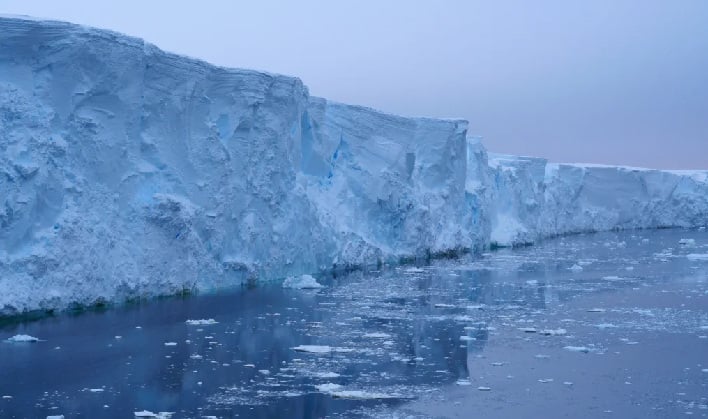
Scientists who conducted a six-year study of the Thwaites glacier, often dubbed the “doomsday glacier,” say the outlook for the massive iceberg is “grim.” The research team, using ice-breaking ships and underwater robots, determined the iceberg is melting at an accelerating rate which could put it on an irreversible path to collapse.
Thwaites glacier in Antarctica is a massive chunk of ice that is comparable in size to Britain or Florida. According to experts, its collapse alone would raise sea levels by 65 centimeters. The collapse would also trigger a larger loss of ice sheet covering West Antarctica, leading to a calamitous sea level rise of 3.3 meters (almost 11 feet), and in turn threaten cities such as New York, Kolkata, and Shanghai.
The researchers say Thwaites’ melting has accelerated considerably over the last 30 years, and that rapid ice loss is set to speed up this century. Rob Larter, a marine geophysicist at the British Antarctic Survey and part of the International Thwaites Glacier Collaboration (ITGC), remarked, “Our findings indicate it is set to retreat further and faster.”

Making the glacier even more vulnerable is the fact it rests on a bed of rock that is well below sea level and is being melted from the underside by warmer seawater. Making matters even worse is the bedrock slopes downward towards the interior of the ice sheet. Therefore, as the glacier melts, even more ice is exposed to warm seawater, threatening to accelerate the collapse.
“The bed gets deeper and deeper,” explained Mathieu Morlighem at Dartmouth College in Hanover, New Hampshire, and a member of the ITGC. “We know that’s unstable.” He added he and his colleagues used computer models to predict the future state of the glacier under different levels of carbon dioxide in the atmosphere, noting, “for almost any carbon emission scenarios, we run into this instability.”
While the team of scientists cannot place a definitive timeline to the ultimate collapse of the Thwaites glacier, they do predict Thwaites and the Antarctic Ice Sheet could collapse within 200 years.
The team sent a torpedo-shaped robot called Icefin to explore the Thwaites’ grounding line, the point at which the ice rises up from the seabed and starts to float. Kiya Riverman, a glaciologist at the University of Portland, remarked about the first time Icefin swam up to the grounding line, “For glaciologists, I think this had the emotional impact that perhaps the moon landing had on the rest of society. It was a big deal. We were seeing this place for the first time.”
The images Icefin sent back allowed the scientists to determine the glacier is melting in unexpected ways, with warm ocean water able to funnel through deep cracks and “staircase” formations in the ice.
With all the bad news concerning the melting of the Thwaites glacier, there is a glimmer of good news as well. The team say there is still time to influence how rapidly this process occurs, by making more efforts to reduce carbon emissions. Morlighem remarked, “We can buy us time. We still have control on how quickly Thwaites loses mass.”